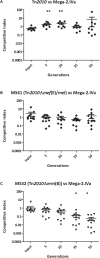High-Level Macrolide Resistance Due to the Mega Element [ mef(E)/ mel] in Streptococcus pneumoniae
- PMID: 31105666
- PMCID: PMC6491947
- DOI: 10.3389/fmicb.2019.00868
High-Level Macrolide Resistance Due to the Mega Element [ mef(E)/ mel] in Streptococcus pneumoniae
Abstract
Transferable genetic elements conferring macrolide resistance in Streptococcus pneumoniae can encode the efflux pump and ribosomal protection protein, mef(E)/mel, in an operon of the macrolide efflux genetic assembly (Mega) element- or induce ribosomal methylation through a methyltransferase encoded by erm(B). During the past 30 years, strains that contain Mega or erm(B) or both elements on Tn2010 and other Tn916-like composite mobile genetic elements have emerged and expanded globally. In this study, we identify and define pneumococcal isolates with unusually high-level macrolide resistance (MICs > 16 μg/ml) due to the presence of the Mega element [mef(E)/mel] alone. High-level resistance due to mef(E)/mel was associated with at least two specific genomic insertions of the Mega element, designated Mega-2.IVa and Mega-2.IVc. Genome analyses revealed that these strains do not possess erm(B) or known ribosomal mutations. Deletion of mef(E)/mel in these isolates eliminated macrolide resistance. We also found that Mef(E) and Mel of Tn2010-containing pneumococci were functional but the high-level of macrolide resistance was due to Erm(B). Using in vitro competition experiments in the presence of macrolides, high-level macrolide-resistant S. pneumoniae conferred by either Mega-2.IVa or erm(B), had a growth fitness advantage over the lower-level, mef(E)/mel-mediated macrolide-resistant S. pneumoniae phenotypes. These data indicate the ability of S. pneumoniae to generate high-level macrolide resistance by macrolide efflux/ribosomal protection [Mef(E)/Mel] and that high-level resistance regardless of mechanism provides a fitness advantage in the presence of macrolides.
Keywords: Mega; Streptococcus pneumoniae; Tn2010; erm(B); macrolide resistance; mef(E)/mel; pneumococcus.
Figures



Similar articles
-
Macrolide Resistance in Streptococcus pneumoniae.Front Cell Infect Microbiol. 2016 Sep 21;6:98. doi: 10.3389/fcimb.2016.00098. eCollection 2016. Front Cell Infect Microbiol. 2016. PMID: 27709102 Free PMC article. Review.
-
Inducible Mega-Mediated Macrolide Resistance Confers Heteroresistance in Streptococcus pneumoniae.Antimicrob Agents Chemother. 2023 Mar 16;67(3):e0131922. doi: 10.1128/aac.01319-22. Epub 2023 Feb 27. Antimicrob Agents Chemother. 2023. PMID: 36847556 Free PMC article.
-
Composite mobile genetic elements disseminating macrolide resistance in Streptococcus pneumoniae.Front Microbiol. 2015 Feb 9;6:26. doi: 10.3389/fmicb.2015.00026. eCollection 2015. Front Microbiol. 2015. PMID: 25709602 Free PMC article.
-
Macrolide resistance mechanisms among Streptococcus pneumoniae isolated over 6 years of Canadian Respiratory Organism Susceptibility Study (CROSS) (1998 2004).J Antimicrob Chemother. 2007 Oct;60(4):733-40. doi: 10.1093/jac/dkm273. Epub 2007 Aug 2. J Antimicrob Chemother. 2007. PMID: 17673477
-
Regional trends in beta-lactam, macrolide, fluoroquinolone and telithromycin resistance among Streptococcus pneumoniae isolates 2001-2004.J Infect. 2007 Aug;55(2):111-8. doi: 10.1016/j.jinf.2007.04.006. Epub 2007 Jun 12. J Infect. 2007. PMID: 17568680 Review.
Cited by
-
Phenotypic and Molecular Characterization of Penicillin and Macrolide-Resistant Streptococcus pneumoniae Serotypes Among Pediatric Patients in Addis Ababa, Ethiopia.Infect Drug Resist. 2021 May 12;14:1765-1772. doi: 10.2147/IDR.S309876. eCollection 2021. Infect Drug Resist. 2021. PMID: 34012275 Free PMC article.
-
Prior exposure to microcystin alters host gut resistome and is associated with dysregulated immune homeostasis in translatable mouse models.Sci Rep. 2022 Jul 7;12(1):11516. doi: 10.1038/s41598-022-15708-3. Sci Rep. 2022. PMID: 35799048 Free PMC article.
-
Impact of untreated tannery wastewater in the evolution of multidrug-resistant bacteria in Bangladesh.Sci Rep. 2024 Sep 2;14(1):20379. doi: 10.1038/s41598-024-71472-6. Sci Rep. 2024. PMID: 39223208 Free PMC article.
-
Prophylactic Inhibition of Colonization by Streptococcus pneumoniae with the Secondary Bile Acid Metabolite Deoxycholic Acid.Infect Immun. 2021 Nov 16;89(12):e0046321. doi: 10.1128/IAI.00463-21. Epub 2021 Sep 20. Infect Immun. 2021. PMID: 34543118 Free PMC article.
-
Pharmacokinetics and Pharmacodynamics of Nemonoxacin in a Neutropenic Murine Lung Infection Model Against Streptococcus Pneumoniae.Front Pharmacol. 2021 May 4;12:658558. doi: 10.3389/fphar.2021.658558. eCollection 2021. Front Pharmacol. 2021. PMID: 34017256 Free PMC article.
References
Grants and funding
LinkOut - more resources
Full Text Sources
Miscellaneous

